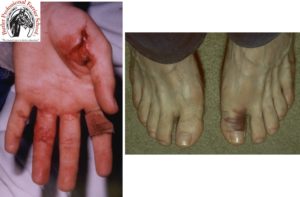Farrier Safety

Injuries are common when working with unpredictable horses. However, many injuries like these (left: nail protruding from hoof torn through farrier’s hand when horse pulled its foot away; right: broken toe from a horse stomping on the farrier’s foot) could have been prevented by following safety protocols.
Horses are unpredictable. They have minds of their own. There are so many ways horses can hurt you. They can react quickly and may jump, run, kick, strike, fall on and/or bite a person without warning. (As you gain experience, you will recognize changes in equine behavior that could become dangerous.) Workman’s Compensation insurance for farriers is traditionally high. Don’t fail to have accident insurance when working with horses.
Most farrier injuries are from the tools he or she uses. Farriers use sharp knives, abrasive rasps, hot tongs, and heavy hammers.
Forge use adds a whole new dimension of possible injury. Burns, of course, are inevitable from hot shoes that look cold and even from the forge itself. Portable propane tanks must be secured and made safe when not in use. Serious injury can result from reckless use of propane tanks.
Steel-toed lace up work boots with ankle support are recommended when shoeing. Proper clothing in addition to leather boots is essential. Cotton clothing that covers the arms and the legs is recommended. Braces on the wrist, elbow, knee and waist may be used. However, too frequent use of support wraps causes a dependence on them. Some farriers opt to wear gloves.
We insist that eye, ear and apron protection be worn when students are working.
Safety glasses are a priority. Particles of metal from shoes or tools and pieces of hoof can damage the cornea of the eye. A craftsman’s eyes are irreplaceable and they are your most important tools. Protect them!
Ear protection is also essential. The ring of the anvil can destroy your hearing. Make it a habit to wear ear protection when working at the anvil. Types range from inexpensive foam plugs to expensive noise suppressors that cover the ear. Individually molded types are the most comfortable. Ear protection has the added benefit of allowing you to strike the shoe harder and thereby be more efficient.
Foot protection is frequently neglected. Horses are easily spooked and may jump on your toes and seriously damage them. Leather boots that support the ankle are a wise investment. Steel toes and plastic metatarsal guards are also available.
To protect the legs from nail wounds and hot metal, leather aprons have been worn by farriers for centuries. Cotton clothing is less likely than other fabric to be burned by metal scale and weld spatter. A cap provides shade and protects hair from sparks.
Make sure your tetanus immunization is current before working with tools and horses. Most doctors recommend a booster every 10 years.
Buy a good first aid kit and keep it near your work area. It should contain band aids, gauze pads, adhesive tape, antiseptic, burn ointment and an eye wash cup.
Proper body conditioning is essential and often overlooked. Frequent water intake is necessary to maintain stamina and mental acuity. Each of us must take responsibility for ourselves and others.
Related Posts
-
Punching a horseshoe nail hole that is clean so the nail fit...Sep 21, 2010 / 0 comments
-
I’m often asked how I would define farrier competency. “...Jun 15, 2010 / 0 comments
-
There are few things that can compare to the soul refreshmen...Jul 10, 2013 / 0 comments
Blog Categories
- Anatomy
- Best Business Practices
- Conformation
- Current Events
- Customer Service
- Draft Horse Shoeing
- Equine Soundness
- Essential Anatomy Kit
- Farrier Careers
- Farrier training
- Foal soundness
- Horse Care
- Horse Foot Care
- Horse Owner Tips
- Horsemanship
- Horseshoeing
- Horseshoeing History
- Iron and Forge Work
- Student Spotlight
- Uncategorized
- Veterinary Care
Blog Archives
Contact Us
Butler Professional Horseshoeing School
495 Table Road
Crawford, NE 69339
(800) 728-3826
jacob@dougbutler.com
Subscribe to Our Blog
Get Our Free e-Book!
If you think you want to become a farrier (or know someone who does), this book can help you make that decision. Horse owners will learn the importance of choosing a qualified farrier and how to select the “right” one.
[ Get the e-Book Now! ]
- Follow:
